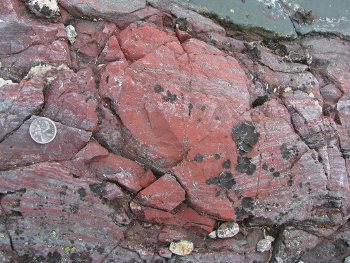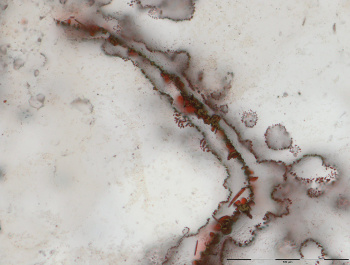Old Fossils
March 30, 2017
Children haven't yet been
indoctrinated to the concepts of
political correctness, so they can often be unkind.
Students are apt to compare their
teachers with various
animals, but one of the most common complaints is that their teacher is "an old
fossil." This might be because
youngsters think that everyone older than their
parents is truly ancient, and teachers tend to persist in their jobs through a normal
retirement age.
Now, anything that qualifies as a fossil should be old; but, how old can an
old fossil be? While the
Earth is about
four and a half billion years old, during its first 500 million years, the so-called
Hadean eon, it was too hot and
too dry to support
life.
Not that life needs to be near
room temperature.
Hyperthermophiles, heat-loving
organisms that exist on Earth, today, can live in water above 100
°C, provided, however, that the water doesn't
boil. This condition is met in the
deep oceans, where the
pressure is high. The pressure at the bottom of the
Marianas Trench, the deepest part of the world's
oceans, is about a thousand
atmospheres.

Boiling point of water as a function of pressure.
A bar is almost exactly one atmosphere pressure.
(Graphed using Gnumeric.)
Since there are no markers that allow subdivision the Hadean,
geologists refer to Hadean
periods with reference to their
lunar counterparts. The end of the Hadean corresponds to the lunar
Nectarian that ended about 3,850 million years ago. At that time, the
Late Heavy Bombardment, a period when the Earth was frequently impacted by huge
asteroids, was ending, and Earth's oceans began to appear.
While the
isotopic distribution of
carbon in
zircons dated to 4.1 billion years ago indicates the possibility that the carbon is of
biological origin,[1] the first acknowledged
evidence for life is found in the
Archean Eon, which started 4 billion years ago, after the Hadean. This evidence, which is still
chemical in nature, is the presence of
iron bands in
rocks dated at 3.7 billion years ago. Such banding would have required an
oxygen atmosphere, presumably supplied by
photosynthesis.
Chemical Evolution is the title of a 1969 book by
Melvin Calvin,[3] and
chemical evolution is the study of the
chemistry of early life, even before the appearance of fossil shapes in the
geological record. Calvin, who was one of the first
astrobiologists for the simple reason that the chemical pathways to life on
Earth can occur elsewhere, was awarded the 1961
Nobel Prize in Chemistry "for his
research on the
carbon dioxide assimilation in
plants," commonly called the
Calvin cycle.

From the preface to Chemical Evolution by Melvin Calvin.[2]
"The study of chemical evolution is based upon the assumption that life appeared on the surface of the earth as a result of the normal operation of the laws of physics and chemistry. This implies that there must have been a period of time in the earth's history that encompassed the transition between a non-living molecular population on its surface and a population of molecular aggregates that we would call living."
(The cover of my wife's copy.)
Such chemical traces are not really fossils, but at 3.5 billion years ago
stromatolites formed by
microorganisms appeared, and they are evidenced in the geological record.[3] A recent study has pushed back the date of earliest fossil evidence to at least 3.77 billion years ago; and, possibly, as early as 4.28 billion years ago.[4-8] The study was conducted by a large international team from the
London Centre for Nanotechnology (London, UK),
University College London (London, UK), the
Geological Survey of Norway (Trondheim, Norway), the
U.S. Geological Survey (Reston, Virginia), The
University of Western Australia (Crawley, Australia), the
University of Ottawa (Ottawa, Canada), and the
University of Leeds (Leeds, UK).[4]
When searching for very old fossils, it's important to look in the right place. It's believed that the earliest life may have begun around
hydrothermal vents, and
microbes are found around such vents, today.[4,7] The research team looked in rocks from the
Nuvvuagittuq Greenstone Belt in
Quebec, Canada, where rocks have been dated from 3.77 billion years to 4.22 billion years ago.[4,6] This deposit was once part of the ancient
ocean floor, and it includes very old
sedimentary and
volcanic deposits.[5-7]
These rocks were in an area where hydrothermal vents would have provided hot, chemically rich water on which ancient microbes might feed. Found within these rocks were
micrometer-scale hematite tubes and filaments that resemble similar structures left by iron- and
mineral-feeding organisms living near hydrothermal vents, today.[4,6] These structures were encased in
quartz.[5] The rocks contain
carbonate and
carbonaceous material with
isotopically light carbon, which is another indicator of life.[4] Living organisms preferentially ingest
12C over
13C, so a high
ratio of light to heavy carbon is a sign of life.

hematite chert, an iron-rich silica rock, at the Nuvvuagittuq Greenstone Belt in Quebec, Canada.
The coin, a Canadian quarter, is 23.88 mm in diameter.
(Photo by Matthew Dodd, University College London, via Flickr.)
Scientists are cautious people, so the research team looked at the possibility that these hematite tubes and filaments could have formed non-biologically.[5] Not only was this unlikely, but the hematite was found in combination with
graphite,
apatite and carbonate that are also associated with fossil organisms.[5] The carbon-containing
compounds were arranged in
rosettes, which is another indication of biological activity.[8] Also, the tubes and filaments were regularly arrayed, as they would be if formed biologically, and the similarity in form to traces from other hydrothermal fossils was striking.[8]
Says
Matthew Dodd, first
author of the
paper and a
Ph.D. student at the University College London,
"Our discovery supports the idea that life emerged from hot, seafloor vents shortly after planet Earth formed. This speedy appearance of life on Earth fits with other evidence of recently discovered 3,700 million year old sedimentary mounds that were shaped by microorganisms."[5]
These findings are not without
controversy. The rocks have undergone alteration by
temperature and pressure,[7] and the shapes of the filaments and tubes are simpler than those found in recent deposits.[6-7] Also, it's not commonly believed that organisms would have used oxygen so early in Earth's history. Also, there's the problem of the wide range in isotopically determined date, as young as 3.77 billion years, and as old as 4.28 billion years old.[8] Also, the structures might be quite a bit younger than the associated rock.[8]
This fossil discovery, if verified, would be important to the possibility of
life on Mars. If life can develop so quickly on a
planet, then it might have developed on Mars in its early existence, when it was still a warm and wet planet.[6] Says Dodd, "These organisms come from a time when we believe Mars had
liquid water on its surface and a similar atmosphere to Earth at that time."[7] Caution is advised, since there's a parallel to the controversial detection of fossil remains of "nanobacteria" in
Martian meteorite ALH 84001, a piece of Mars that was ejected into
space and landed on Earth, in
Antarctica.[8]

Hematite filament, and associated hematite nanoscale features, from the Nuvvuagittuq Greenstone Belt, Quebec, Canada.
The scale bars, just visible, are 100 μm.
(Photo by Matthew Dodd, University College London, via Flickr.)
References:
- Elizabeth A. Bell, Patrick Boehnke, T. Mark Harrison, and Wendy L. Mao, "Potentially biogenic carbon preserved in a 4.1 billion-year-old zircon," Proc. Natl. Acad. Sci., vol. 112, no. 47 (November 24, 2015), pp. 14518-14521. This is an open access article with a PDF file here.
- Melvin Calvin, "Chemical Evolution," Oxford University Press, 1969, ISBN 0-19-855342-0, 278 pp. (via Amazon).
- Nora Noffke, Daniel Christian, David Wacey, and Robert M.Hazen, "Microbially Induced Sedimentary Structures Recording an Ancient Ecosystem in the ca. 3.48 Billion-Year-Old Dresser Formation, Pilbara, Western Australia," Astrobiology, vol. 13, no. 12 (December, 2013), pp. 1103-1124, doi:10.1089/ast.2013.1030.
- Matthew S. Dodd, Dominic Papineau, Tor Grenne, John F. Slack, Martin Rittner, Franco Pirajno, Jonathan O’Neil & Crispin T. S. Little, "Evidence for early life in Earth’s oldest hydrothermal vent precipitates," Nature, vol. 543, no. 7643 (March 2, 2017), pp. 60-64, doi:10.1038/nature21377.
- World’s oldest fossils unearthed, University College London Press Release, March 1, 2017.
- Charlie Wood, "Canadian fossils: Evidence of the oldest form of life yet seen?" Christian Science Monitor, March 2, 2017.
- Pallab Ghosh, "Earliest evidence of life on Earth 'found'," BBC News, March 1, 2017.
- This May Be the Oldest Known Sign of Life on Earth, National Geographic, March 1, 2017.
Permanent Link to this article
Linked Keywords: Child; Children; indoctrination; indoctrinated; political correctness; student; teacher; animal; fossil; youth; youngster; parent; retirement; Earth; age of the Earth; Hadean; eon; water on Earth; life; room temperature; hyperthermophile; organism; celsius; °C; boiling; boil; deep sea; deep ocean; pressure; Marianas Trench; ocean; atmosphere; boiling point; water; function; bar; atmospheric pressure; Gnumeric; geologist; period; lunar geologic timescale; Nectarian; Late Heavy Bombardment; asteroid; isotope; isotopic; probability distribution; carbon; zircon; biology; biological; scientific evidence; Archean Eon; chemistry; chemical; iron; rock; oxygen; photosynthesis; Melvin Calvin; molecular evolution; chemical evolution; geological record; astrobiology; astrobiologist; Nobel Prize in Chemistry; research; carbon dioxide; assimilation; plant; Calvin cycle; preface; physics; molecule; molecular; stromatolite; microorganism; London Centre for Nanotechnology (London, UK); University College London (London, UK); Geological Survey of Norway (Trondheim, Norway); U.S. Geological Survey (Reston, Virginia); University of Western Australia (Crawley, Australia); University of Ottawa (Ottawa, Canada); University of Leeds (Leeds, UK); hydrothermal vent; microorganism; microbe; Nuvvuagittuq Greenstone Belt; Quebec, Canada; seabed; ocean floor; sedimentary rock; volcanic; micrometer; hematite; mineral; quartz; carbonate; carbon; carbonaceous; material; isotope; isotopically; ratio; chert; silicon dioxide; silica; coin; Canadian quarter; diameter; Flickr; scientist; graphite; apatite; chemical compound; rosette; Matthew Dodd; author; scientific literature; paper; Doctor of Philosophy; Ph.D.; postgraduate education; controversy; temperature; life on Mars; planet; liquid; Martian meteorite<; ALH 84001; outer space; Antarctica; hematite; nanoscopic scale; nanoscale; linear scale; scale bar; micrometer; μm; Melvin Calvin, "Chemical Evolution," Oxford University Press, 1969, ISBN 0-19-855342-0, 278 pp.